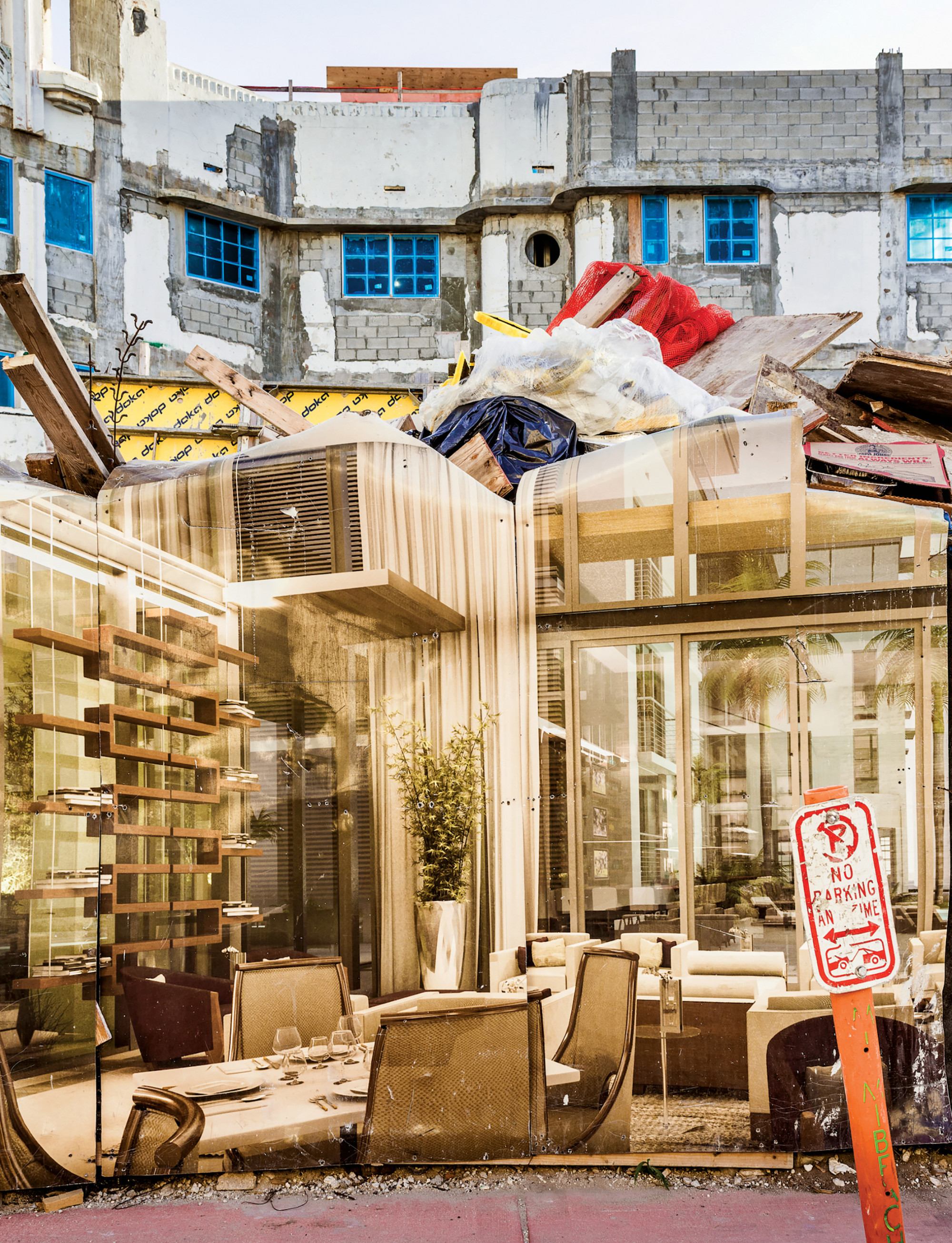Miami Is Changing but Its Baked Cheese Bread Endures
On Pandebono and the vanishing city
By Rahawa Haile

Construction in South Beach II, 2018, a photograph by Anastasia Samoylova © The artist. From her monograph Adaptation, published last year by Thames & Hudson
As a child, I came to know Miami by chasing the notes on the air. From medianoches and boomboxes, through juiced oranges and blooming fiddlewood. Each sense of mine feasted in those early years, the memories threaded now with the voice of Celia Cruz and the spray of a crashing Atlantic.
Flavors from every inch of the Caribbean and Latin America guided me: Argentinian empanadas, Jamaican beef patties, Bajan curry chicken roti, Venezuelan arepas pelúa. Growing up, I had all the spiced and sweetened world at my fingertips, the crumbs from those hand pies freckling my tiny palms.
My favorite breakfast staple in a city rich in options was pandebono, a Colombian cheese roll made with cassava starch. Its texture is chewy like mochi; its taste warm and sweet. The cheese, often queso fresco in the U.S., is distributed throughout the dough, so that each bite melts pleasurably. If the feeling of basking in the day’s first light could be a food, it would be this one. And should you think my enthusiasm singular, in 2024 Miami-Dade County Public Schools even added pandebono bites to their students’ free breakfast options.
Pop into any Sedano’s Supermarket in Miami, a Florida chain catering to the Latin American diaspora, and you’ll find rows of pandebono waiting. Local Colombian bakeries know better than to run short of the humble rounds on weekend mornings.
During my years in New York, whenever I felt a particular kind of homesick, I made my way to Rico Pan Bakery in Queens. On trips to catch a Mets game, a stop in Woodside for the treat was a given. Many South American countries enjoy their own version of the snack, with the type of cheese used dependent on regional appetites. (Brazil, for example, has a similarly disc-shaped pão de queijo.)
Now that I live in Oakland, I’ll swing by Macondo in Alameda for pandebono on the way to birdwatch at the island’s southeastern shore. Nothing compares to memory, but also nothing compares to memory: the hazy days of ordering several rolls and a soda for me, a cortado for my dad, and a tall bottle of mango nectar to sip throughout the weekend.
Memory is also what makes my wanderings through Miami today so difficult to bear.
To say that Miami has gotten expensive in the last five years would be an understatement. At present, Miamians are among the most rent-burdened people in the United States. In 2022, the city’s pandemic housing spike was the largest in the nation at 58%. Residents who called Miami home long before COVID and the tech boom have since been pushed out, while an influx of domestic and international wealth has scooped up available units. Last November, an estimated 37% of home sales in Miami-Dade and Broward counties were all-cash, twelve percent higher than the national average. Meanwhile, the city’s median home price of $635,000 is approximately twice what it was in November 2019.
If Miami has emerged as a “steal” for investors in these last years, it’s come at the cost of those with the most to lose from their newfound precarity.
Despite the expanding class divide, certain aspects of the city’s cultural fabric, such as its famed coffee culture, remain sacred. While the owners of the cafes and bakeries that blanket Miami are feeling the sting of inflation, leading to unavoidable increases for consumers at checkout, business continues to boom. “The average price for a colada at twenty of Miami-Dade’s most popular ventanitas, from Homestead to Hialeah, is now $2.06—twice what it cost at many Cuban coffee windows like Sergio’s Cuban restaurant in 2019,” wrote reporter Carlos Frías in 2023. These ventanitas are walk-up windows that sit at the intersection of Italian espresso culture and your typical to-go counter. Here, one might order a colada, which consists of four ounces of Cuban coffee meant to be poured among friends into the accompanying Cafecito containers—plastic cups the size of thimbles. This might not seem like a big deal, but think of the colada as Miami’s version of Costco’s $1.50 hot dog and soda combo—a beloved loss-leader whose dependability is the point. (Costco’s co-founder Jim Sinegal once threatened to kill one of the company’s previous CEOs if he ever raised the price.)

Photograph © Luis Echeverri Urrea/Adobe Stock
If I close my eyes and focus, I can hear the crinkling of a drained Cafecito cup crushed between thumb and index finger. The pocket change slides back across the open window counter, toward the cashier, with a rasp followed by soft-knuckled taps against the linoleum, a stand-in for “goodbye.” There is my father, holding my hand as we cross the street to La Carreta, when the line’s grown too long for pastelitos at Versailles. The golden flakes from the guava-filled pastry’s laminated dough fall softly on my chin as we drive west on a Saturday morning, easing along Southwest 8th Street for fifteen miles until we enter the Everglades. The asphalt gash of Tamiami Trail splits the sawgrass sea.
As much as Miami is synonymous with flamingos and partying, it’s these vignettes of food, freedom, and airboat rides that remain inextricably linked to my home in my mind. It’s the live bait from the gas station kitty-corner to the Miccosukee Casino and Resort, purchased for my tackle box at the age of nine. The crunch of battered frog legs and fried gator at Joanie’s Blue Crab Café before we turn around to head home.
I understood the ventanita as part of a daily ritual, one in which freshly caffeinated older men chatted with strangers about the day while their children played. Though my father spoke fluent Spanish, I spoke broken Spanglish at best. I spent most of our trips there in silence as I watched the other Spanish-speaking kids—sometimes doing their best to include me while running between the green, fanback patio chairs, almost always sharing whatever box of pastries was placed before us. It awes me, in hindsight, how little we needed to understand of the other for unprompted kindness.
Cities inevitably change, but whatever Miami is becoming feels largely driven by the expendability of those already there. The thinning of the city’s Black community is palpable, the disinvestment more pronounced. Little Haiti, a region of Miami considered “ground zero for climate gentrification” continues its slide into historic memory, while new documentaries like Razing Liberty Square, centered on neighboring Liberty City, shine a spotlight on the targeted destruction of Black neighborhoods by developers. With the cost of living skyrocketing, many Black Miamians have left the county for the more affordable Broward County to the north. Between 2010 and 2020, Broward’s Black population saw an overall gain of 22%.
Saddest, perhaps, has been the leveling of the West Grove section of Coconut Grove, an area settled by Bahamian immigrants in the late 1800s, years before Miami’s incorporation as a city. In 1896, nearly half of the men who signed those incorporation papers were Black. As Miami community historian Nadege Green put it, “Miami is a Deep South American city with Bahamian roots.” The Goombay Festival I attended in my youth—filled with brass instruments, peppery conch fritters, and parades of feathered outfits celebrating Bahamian culture—has endured for almost fifty years, though these days less as a reflection of the neighborhood but rather as a nod to the neighborhood that was and might never be again. Recently, a group of West Grove advocates filed a complaint with the U.S. Department of Housing and Urban Development arguing that Miami’s complicity in the gentrification of the area was a violation of the 1968 Fair Housing Act. As a reporter for the Miami Herald wrote in 2022, “The West Grove has seen its lush, narrow residential streets of timeworn cottages, bungalows and modest duplexes overtaken by lot-filling, multimillion-dollar ‘sugar-cube’ luxury homes and their mostly white occupants.”
Increasingly, Miami feels like a memory of a memory of a place, one constantly eroding in the quest to build itself anew, not unlike New Orleans or Charleston. There’s no easy way to make peace with saying farewell to the city I knew and loved, though I suspect it would involve a pandebono and cafe con leche savored in Tropical Park, seasonal home of South Florida’s beloved Santa’s Enchanted Forest for forty years, whose lease the city elected not to renew in 2021.
This story was published in the print edition as “On Pandebono and the Vanishing City.” Buy the issue this article appears in here.




